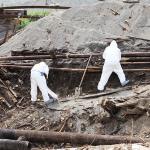(Updated July 17th, 2023)
Mesothelioma represents one of the most notorious acts of corporate crime. This fatal form of cancer is only caused by exposure to asbestos. Yet despite being a known carcinogen since the 1930s, for decades, companies still used asbestos in their building materials and insulation. In doing so, they endangered the health of thousands of their employees and consumers alike. According to reports from the Mayo Clinic, Roughly 66,951 Americans were diagnosed with mesothelioma between 1999 and 2019, and about 54,905 Americans died from mesothelioma between 1999 and 2020.
What is Mesothelioma?
As defined by the Mayo Clinic, mesothelioma is a rare type of cancer that develops in the layer of tissue that covers the majority of your internal organs, also known as the mesothelium. There are four types of mesothelioma:
- Pleural mesothelioma, which affects the lungs and is considered the most common.
- Peritoneal mesothelioma, which affects the abdomen.
- Pericardial mesothelioma, which affects the heart.
- Mesothelioma of the tunica vaginalis, which is an extremely rare disease that affects the testicles.
Mesothelioma is an extremely aggressive form of cancer, and while there is treatment available, there is no cure, and half of the patients who are diagnosed will succumb to the disease within 18 months. According to the International Labor Organization, roughly 10 million people will die from asbestos-related cancer by 2030.
What Causes Mesothelioma?
Mesothelioma is caused by inhaling or swallowing asbestos fibers. When asbestos is handled, its fine fibers are then released into the air. Victims who are in the area will then inhale the shard-like fibers that will stick to the protective mesothelium layers of the body’s organs, where they can stay for years. Eventually, the fibers will create cancerous cells in the body. Symptoms can take anywhere from 15-to-20 years to show after exposure.
What is Asbestos?
Asbestos is a term applied to six types of cancer-causing minerals that occurs in rocks and soil, including chrysotile, actinolite, amosite, anthophyllite, crocidolite, and tremolite. Asbestos is made up of long, thin, and very strong fibers, and the fibers do not evaporate or dissolve in water. The mineral is also known for its carcinogenic properties and fibrous structures, and it possesses resistance to heat, chemicals, electricity, and corrosion.
Asbestos is labeled as the “Magic Mineral.”
For thousands of years, humans have used asbestos as a building tool. The mineral has been discovered in artifacts dating back to the Stone Age and Ancient Egypt. However, the mineral was not widely used until the beginning of the 20th century, when it was first mined and exported worldwide. Thanks to its durable qualities and for its heat and chemical-resistant properties, asbestos was advertised as a “magic mineral.” From then on, the magic mineral was mainly used in building materials and insulation but was also found in automotive parts and textiles.
Between the 1930s and 1970s, the U.S. Navy found use for the mineral, with nearly every Naval ship containing several tons of asbestos. However, during those same years, exposure to asbestos was linked to cancer, and by the 1970s, research proved it was a carcinogen. According to the Centers for Disease Control (CDC), an estimated 27 million American workers had been exposed to asbestos between the 1940s and 1970s.
Banning Asbestos
On July 12, 1989, the U.S. Environmental Protection Agency issued a final rule to ban the majority of asbestos products. However, it was overturned on Oct. 18, 1991. However, the Environmental Protection Agency (EPA) later received clarity on the lift from the court, stating that the ban could still apply to asbestos products that were not manufactured, processed, or imported on July 12, 1989. Thus the Asbestos Ban and Phase-Out Rule (ABPR) was announced. The ABPR determined the following six categories of asbestos-containing products fit the classification:
- Commercial paper
- Corrugated paper
- Flooring felt
- New uses of asbestos
- Rollboard
- Specialty paper
A few years later, in 2002, U.S. Sen. Patty Murray introduced the Ban Asbestos in America Act, also known as the Murray bill, which originally aimed to completely ban asbestos in the U.S. as well as three other durable fibers with a similar structure to asbestos–While the bill passed the U.S. Senate, in 2007; unfortunately, it died in Congress. Then in 2019, the Alan Reinstein Ban Asbestos Now Act was introduced. However, like its predecessor, in October 2020, the bill stalled in Congress and was never passed. As of now, public health officials still support the ban of asbestos in the United States. However, no new legislation has been announced since 2019.
*Disaster Survivors and Students Are Exposed to Asbestos
Asbestos has been called a silent, enduring pandemic. While asbestos is no longer mined in the United States, and its use has declined in recent years, according to the United States International Trade Commission, nearly 114 metric tons of asbestos were imported in the first three months of 2022. In 2021, only 100 metric tons were imported for the entire calendar year. So it is safe to say that many Americans still come into contact with the mineral. More specifically, victims come into contact with the mineral in buildings that are older or that are improperly destroyed or renovated.
In the case of a disaster, often, safety regulations are ignored during cleanup in favor of speed rather than safety, which can leave construction workers, safety workers, volunteers, and surrounding individuals at risk of exposure. For example, in 2001, when the twin towers collapsed, it was reported that the buildings released an estimated 2,000 tons of asbestos, coating Lower Manhattan in toxic dust. Making matters worse, cleanup, search, and rescue workers were not provided with adequate protection gear, leaving an estimated 41,000 victims exposed to asbestos.
In 2005, asbestos was also considered a public health concern after Hurricane Katrina. According to the Environmental Protection Agency (EPA), they warned that roughly 100 pollutants, including asbestos, were possibly in the flood waters. Stacked on top of the contaminated water, the demolition and removal of building materials containing asbestos did not follow EPA regulations. Because of this, asbestos and other toxic waste were deposited in regular landfills that were not equipped to contain the pollutants.
In recent years, multiple cases of exposed asbestos have been found schools across the U.S. In 2018, children were potentially exposed to asbestos after a contractor made errors at Lafayette Academy Charter School in New Orleans. In 2015, Chicago Public Schools had not removed or issued repairs for reported cases of asbestos noted by inspectors in 2013 at three different schools. These are only a few of the cases in recent years. However, asbestos is still endangering the lives of thousands of Americans every year.
What Are the Symptoms of Mesothelioma?
According to the Mayo Clinic, depending on the type of mesothelioma, the symptoms may vary. Symptoms for pleural mesothelioma, known as the most common form of mesothelioma and occurs in the lungs—can include, but are not limited t, the following:
- Chest pain
- Excessive sweating
- Fatigue
- Fever
- Fluid in the lungs
- Persistent cough
- Shortness of breath
- Weight loss
- Wheezing
Peritoneal mesothelioma, which occurs in tissue in the abdomen, symptoms can include:
- Abdominal pain
- Abdominal swelling
- Nausea
- Unexplained weight loss
Pericardial mesothelioma, which affects the tissue surrounding the heart, can include difficulty breathing and chest pains. Mesothelioma of tunica vaginalis, which affects the tissue surrounding the testicles, may be detected as swelling or a mass on a testicle. However, these two types are considered to be the most rare, and symptoms are difficult to identify on your own. For those who believe they or a loved one has been exposed to asbestos and are exhibiting signs of mesothelioma, we highly encourage you to seek medical attention.
Who Is at Risk for Developing Mesothelioma?
Anyone who has been exposed to asbestos is at risk of developing mesothelioma. However, groups who are particularly susceptible to developing mesothelioma include the following:
- Boilermakers
- Construction workers
- First responders
- Mechanics
- Miners
- Railroad workers
- Refinery workers
- Shipyard workers
- Veterans (especially from the U.S. Navy)
If you or a loved one were diagnosed with mesothelioma, you may be entitled to compensation. For over 35 years, our attorneys have helped thousands of mesothelioma victims across the United States recover millions of dollars. To learn more information regarding mesothelioma, victims can contact a class action attorney today for a free, no-obligation legal review. We're available for you 24 hours, 7 days a week.





